Ultra-high Stability Miniature OCXOs
MTI-Milliren Technologies Inc.
Newburyport, MA
The current drive for miniaturization and low cost commercialization is also affecting oven-controlled crystal oscillator (OCXO) products. Although burdened by a discrete oven that stabilizes the crystal oscillator’s thermal environment, modern OCXO designs must be smaller and less expensive than their predecessors without sacrificing performance or reliability. The 270 series OCXOs utilize a double-oven configuration in a miniature package and feature ultra-high stability as well as high reliability. The new crystal oscillators have been designed with the industry-standard Euro CO-8 footprint and serve as a drop-in replacement for the 230 series oscillator products.
Housed in a hermetically sealed 1.423" x 1.071" x 0.765" package, the new OCXOs feature a thermal stability performance of 2.0E-10 to 5.0E-09 over the -30º to +70ºC ambient temperature range that rivals rubidium clock performance. The 270 series OCXOs are the next generation of ultra-stable quartz frequency references, occupying five times less volume than the smallest frequency reference currently available today in the standard 2.0" x 2.0" x 1.5" package.
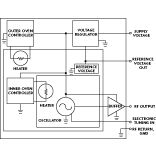 The OCXOs are capable of operating from 4.8 to 90 MHz and utilize a full-size TO-8 quartz resonator. Figure 1 shows the oscillator’s functional block diagram. The double-oven configuration utilizes a steady-state power consumption at 25ºC of 1.7 W from a nominal 12 V DC supply. Warm-up power is typically 5.5 W and requires approximately 10 minutes to reach a frequency stability of 5E-09. Once stabilized, the oscillator’s typical thermal stability over the -30º to +70ºC temperature range is 1E-10. A typical 5 MHz unit’s RF output is a 9 dBm ±2 dB sinewave, harmonics are -30 dBc and spurious are -80 dBc (max). Short-term stability at 1 s is 2E-12, and aging is 1E-10 per day and 3E-08 per year.
The OCXOs are capable of operating from 4.8 to 90 MHz and utilize a full-size TO-8 quartz resonator. Figure 1 shows the oscillator’s functional block diagram. The double-oven configuration utilizes a steady-state power consumption at 25ºC of 1.7 W from a nominal 12 V DC supply. Warm-up power is typically 5.5 W and requires approximately 10 minutes to reach a frequency stability of 5E-09. Once stabilized, the oscillator’s typical thermal stability over the -30º to +70ºC temperature range is 1E-10. A typical 5 MHz unit’s RF output is a 9 dBm ±2 dB sinewave, harmonics are -30 dBc and spurious are -80 dBc (max). Short-term stability at 1 s is 2E-12, and aging is 1E-10 per day and 3E-08 per year.
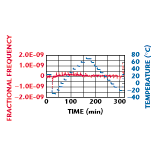 Figure 2 shows the thermal stability performance of a 5 MHz SC-cut third-overtone OCXO as it is swept from -30º to +70ºC and then back to -30ºC using automatic test equipment (ATE). Frequency measurements are made at +25ºC before and after the sweep to eliminate any drift during the test period that is not temperature related. Each data point is taken by averaging 10 frequency readings of 1 s gate intervals approximately every 15 s.
Figure 2 shows the thermal stability performance of a 5 MHz SC-cut third-overtone OCXO as it is swept from -30º to +70ºC and then back to -30ºC using automatic test equipment (ATE). Frequency measurements are made at +25ºC before and after the sweep to eliminate any drift during the test period that is not temperature related. Each data point is taken by averaging 10 frequency readings of 1 s gate intervals approximately every 15 s.
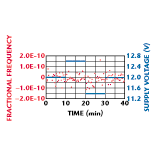 The new OCXO also displays good frequency stability in the presence of supply voltage and load impedance changes. The oscillator’s supply voltage sensitivity dF/dV and load sensitivity dF/dL for a ±5 percent voltage change and a five percent load impedance change are both 5E-11. Figure 3 shows the supply voltage sensitivity of a 5 MHz SC-cut third-overtone oscillator when the +12 V DC supply voltage is varied from +5 percent to -5 percent. Using ATE, the supply voltage is held at +12 V before and after the sweep to eliminate any drift during the test period that is not supply voltage related. Similar to the thermal measurement technique, each recorded data point is taken by averaging 10 frequency readings of 1 s gate intervals approximately every 20 s.
The new OCXO also displays good frequency stability in the presence of supply voltage and load impedance changes. The oscillator’s supply voltage sensitivity dF/dV and load sensitivity dF/dL for a ±5 percent voltage change and a five percent load impedance change are both 5E-11. Figure 3 shows the supply voltage sensitivity of a 5 MHz SC-cut third-overtone oscillator when the +12 V DC supply voltage is varied from +5 percent to -5 percent. Using ATE, the supply voltage is held at +12 V before and after the sweep to eliminate any drift during the test period that is not supply voltage related. Similar to the thermal measurement technique, each recorded data point is taken by averaging 10 frequency readings of 1 s gate intervals approximately every 20 s.
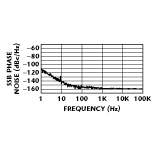 Low phase noise is a prime consideration. The oscillator’s phase noise is a function of the output frequency and is typically specified at -100 dBc/Hz at 1 Hz offset and -155 dBc/Hz at 10 kHz offset for a 5 MHz output. A graph of the phase noise performance of two identical 5 MHz oscillators corrected for equal power source noise is shown in Figure 4 . The oscillator frequency is voltage tuned for minor output frequency adjustments using a 0.5 to 5 V DC external tuning voltage that has a positive slope. Tuning linearity is within 10 percent. The electrical tuning range for a 5 MHz SC-cut third-overtone oscillator is specified as ±4E-007 to ±8E-007. In addition, a 4.7 to 5.3 V high stability reference voltage output is provided with a source resistance of 100 W.
Low phase noise is a prime consideration. The oscillator’s phase noise is a function of the output frequency and is typically specified at -100 dBc/Hz at 1 Hz offset and -155 dBc/Hz at 10 kHz offset for a 5 MHz output. A graph of the phase noise performance of two identical 5 MHz oscillators corrected for equal power source noise is shown in Figure 4 . The oscillator frequency is voltage tuned for minor output frequency adjustments using a 0.5 to 5 V DC external tuning voltage that has a positive slope. Tuning linearity is within 10 percent. The electrical tuning range for a 5 MHz SC-cut third-overtone oscillator is specified as ±4E-007 to ±8E-007. In addition, a 4.7 to 5.3 V high stability reference voltage output is provided with a source resistance of 100 W.
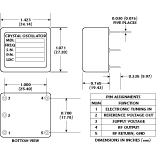 Figure 5 shows the new oscillator’s mechanical outline. A very low active component count helps to ensure high reliability and low cost while preserving the oscillator’s superior performance. The units have been designed for high volume production and are 100 percent tested for thermal stability, aging, output level and spectral purity, phase noise, short-term stability, warm-up and continuous power, reference voltage and electrical tuning range. Many standard frequencies and Stratum II- and Stratum IIIe+-compatible designs are available. Custom frequency outputs can be supplied upon request.
Figure 5 shows the new oscillator’s mechanical outline. A very low active component count helps to ensure high reliability and low cost while preserving the oscillator’s superior performance. The units have been designed for high volume production and are 100 percent tested for thermal stability, aging, output level and spectral purity, phase noise, short-term stability, warm-up and continuous power, reference voltage and electrical tuning range. Many standard frequencies and Stratum II- and Stratum IIIe+-compatible designs are available. Custom frequency outputs can be supplied upon request.
MTI-Milliren Technologies Inc., Newburyport, MA (978) 465-6064.
